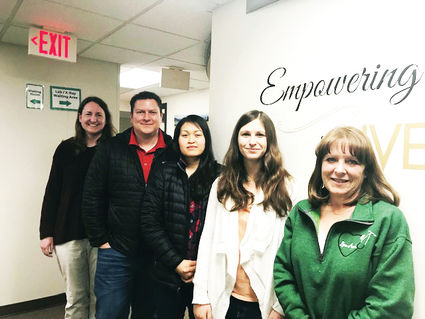Addicted and Hopeful: Opioid Addiction is not new
May 22, 2019

The MAT Team, pictured from left to right: Laura Shellman, FNP; Dustin Ratliff, LCPC; Champ Montanez, BHCM; Christina Hoppe, PsyD; Lou Ann Paulsen, LPN.
Opioid addiction is not new - many have suffered from this epidemic for years. Though highly addictive, opioids alone are not fully to blame for the overwhelming number of addicted individuals. There are other components which contribute to this deadly health concern.
Prescribed to treat acute pain, if a person is taking opioids for extended periods of time their body can become immune to the dose. At this stage, pain increases while the effectiveness of the medication decreases. Additionally, the body often develops a dependency. Once a person is dependent, they can experience withdrawal-like symptoms if they don't take the medicine, which often results in the inability to control the use of the opioid.
According to the Department of Health and Human Services website, in the late 1990s pharmaceutical companies were reassuring the medical community that patients would not become addicted to the opioid pain relievers. Because of this reassurance, providers increased the number of opioids prescribed only to later discover the medications were in fact highly addictive and thus created the opioid epidemic.
Addiction occurs when opioid use interferes with daily living, personal relationships and/or finances. Not only are personal relationships and finances at risk, nearly 52,404 Americans died from opioid overdoes in 2015, and according to the HRSA website 116 people die every day from opiate-related drug overdoses.
Identifying the source of the problem is just once piece of the puzzle. Implementing changes through education and awareness can aid recovery and changing behaviors while keeping in mind the acute pain in which the individual was treated for originally are essential to treating opioid addiction.
In 2017 the Department of Health and Human Services declared a public health emergency to address this crisis. The belief behind this is that declaring a public health emergency will grant organizations like HHS and DEA the ability to appoint specialized individuals to expand treatment access using new technologies such as telemedicine within an integrated healthcare model.
At a local level, programs are being utilized to ensure all persons with an opioid addiction have access to treatment. Medication-Assisted Treatment (MAT) is one such program and has been found useful and extremely effective in improving the health of and addressing addiction in opioid dependent individuals. The MAT program combines the use of medications and behavioral therapy to treat people who have a substance use disorder.
Sweet Medical Center in Chinook is among the first community health centers to implement the MAT program in Montana.
The program began at Big Horn Valley Health Center (BVHC) in the fall of 2016 and has since expanded to their Ashland and Miles City clinic sites and most recently Sweet Medical Center who merged with BVHC earlier this year.
"We've had great success in this community," explained BVHC Registered Nurse and MAT program team member, Heather Bear Cloud, "It takes teamwork, and we have the team available to help."
Sweet Medical Center offers MAT consultations and has staff members available on site to answer any questions. Individuals interested in the program are encouraged to call (406) 357 – 2294 for more information. Bighorn Valley has five comprehensive locations in Montana, Hardin, Ashland, Miles City, Lewistown and Chinook.
If you would like to meet our Chinook MAT team and learn more about our program, be sure to join us at our Meet and Greet, Wednesday, May 29, at the Chinook Senior Center from 2:00 - 5:00 p.m.







